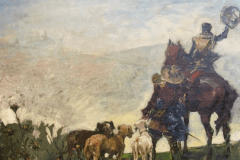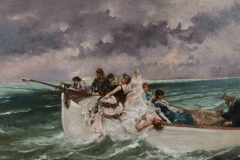Buying Juan Luna paintings – Highest Prices Paid: Artist Bio & images follow:
https://www.youtube.com/watch?feature=player_embedded&v=5KSDx8CLLMM
JUAN NOVICIO LUNA (b. Ilocos Norte, Oct. 24, 1857 d. Dec. 7, 1899)
Juan Luna was the son of Joaquin Luna de San Pedro y Posada and Laurena Novicio y Ancheta. He had four brothers: Manuel, b, 1855, a violin virtuoso; Jose, b. 1861, a physician; Joaquin Damoso, b. 1864, governor, congressman, and senator and Antonio, b. I866, writer and general of the Philippine Revolution Army. On December 7, 1886, Juan married Paz (Chiching) Pardo de Tavera y Gorricho with whom he had two children, Andres Luna San Pedro, and Maria de la Paz. Both died at early ages.
The Lunas transferred to Manila in 1861 enabling Juan to finish his high school at the Ateneo de Manila. In 1869, he enrolled at the Escuela Nautica, where after five years of theoretical courses and practical sailing to Asian ports like Hongkong, Amoy, Singapore, Colombo, and Batavia, he obtained the certificate of piloto de altos mares tercer clase (pilot of the high seass third class). While in Port for six months, he took up landscape painting at the Academia de Dibujo y Pintura. Eventually, he received private lessons from Lorenzo Guerrero, who, perceiving his potential, urged his parents to send him to Spain for further studies. In 1877, Juan executed “Barrio al Lado del Rio” (village by the river) and “Vista de un Barrio con Kapok” (Barrio Scene with Kapok Trees) Towards the end of that year he sailed to Spain.
Luna enrolled at the Real Academia de Bellas Artes de San Fernando in Madrid. There he obtained an award for outstanding color, composition and antique studies but did not stay long. Instead he apprenticed himself with Alejo Vera, a professor of the said school, whom he accompanied to Italy in 1879 when the later went to fulfill commissions there. Upon arriving there, Luna visited the ruins of Pompeii and Naples and made some 40 studies of excavated classical sites and objects now mostly in the National Museum of the Philippines. At this time he finished his miniature “Autoretrato a Edad 22” (Self portrait at 22), in charcoal, and “Dafnis y Chloe,” (Daphnis and Chloe). The latter would soon win him a silver palette from the Centro Artistico Literario de Manila. When Vera went back to Spain, Luna remained behind, staying with the Berdlliure brothers, with whom he was to develop a loyal friendship. He stayed in Rome until spring, 1884, finishing there such pieces as “La Bella Feliz y la Esclava Ciega” (The Happy Beauty and the Blind Slave), “La Muerte de Cleopatra” (The Death of Cleopatra), and the “Portrait of Pedro Paterno.” “Cleopatra” won for him a silver medal at the Madrid Art Exposition of 1881. For this achievement the Ayuntamiento de Manila granted him a four year scholarship upon the instigation by Francisco de Paula Rodoreda. In 1883 he started painting the “Spoliarium,” which won him the first gold medal at the Madrid Art Exposition the following year. A colossal multifigure scene depicting dead gladiators being mourned by their relatives at the basement of the Roman Colosseum, the “Spoliarium” was identified by Jose Rizal as an allusion to the exploitation or the Philippines by Spain.
Luna transferred to Paris in October 1884 but he shuttled back and forth to Madrid as his works, particularly portraits, were now in demand. His presence was also needed by fellow Filipinas who were pushing for reforms in the Philippine colony from the Madrid government. In 1885, he executed “El pacto de Sangre” (Blood Compact) and “Miguel Lopez de Legaspi,” pieces sent to Manila in return for his aforementioned scholarship. He also started “La batalla de Lepanto” (The battle of Lepanto) commissioned by the Spanish Senate upon the influence of King Alfonso XII to be hung beside “La Rendicion de Granada” (The Surrender of Granada) by 1878 grand prize winner Francisco Pradilla. By this gesture, the king hoped to compensate Luna who was not given the grand prize for Spoliarium. Although public sentiment felt he deserved the award, it was withheld from him by a biased jury. In 1886 Luna’s Damas “Romanas” (Roman Ladies) won a diploma of honor at the Munich Salon, and in 1887 his “Mestiza en su Tocador” (Mestiza Lady at her Dresser) won a similar award at the Exposicion General de las Filipinas. In November of the same year, the Queen Regent Maria Cristina unveiled both Luna’s and Pradilla’s paintings at the Madrid Senate, where both are still hanging.
Between 1884 and 1890 Luna also executed city scenes like “En el Palco” (At The Theater Box),1894, “Street Flower Vendors,” 1885, that captured part of the funeral cortege of the author Victor Hugo. He also painted many views of villages and beaches in Normandy and executed portraits of himself, his wife and his children.
Nurtured in the academic classical canons then prevalent all over the western world, Luna followed the conventional steps in attaining professional success, such as obtaining prizes with colossal Graeco-Roman canvases in the grand Classico-Romantic manner at the prestigious atr salons of Europe. By 26 May 1889, however, in his letter to Javier Gomez de la Serna, he vowed his isillusionment with the historical canvas thus: “all historical painting is false starting with the very concept, and those who think that correct drawing, good composition, brilliant coloring and a lot of adornment are enough to make it valid are mistaken.
This statement, however, does not signify Lunas break with the academic tradition nor his sympathy with Impressionism, as many critics earlier presummed, but rather his leaving towards the more progressive faction of the salon “the distant one,” that he described on 5 May 189 to Rizal. Luna first signalled this involvement with “Le Chifonier” (The Rag picker), showing an old man in tattered clothes carrying a basket of rags, which he showed at the Champs-de-Mars in 1889. By 1891, he was reading Le Socialism Contemporain (Contemporary Socialism) by E. de Lavelaye and through this concern, he attained the highest honors he was ever to achieve, namely his acceptance as member of the Societe Nationale de Beaux Arts. This entitled him to exhibit as many as 10 pictures at the Champs-de-Mars without going through the jury. He gained this acceptance through the merits of “Les lgnores” (known as Heroes Anonimos or Los Desherados in Spanish) and “Poor Allan’s Burial” which he showed at the Champs-de-Mars in that year.
In I892, Luna finished “Peuple et Rois” (People and Kings), which he intended to send to the Chicago Universal Exposition of that year. Around that time Luna frequently accused his wife Paz of having an affair with a Monsieur Dussaq. In a fit of jealousy, he killed his wife and mother-in-law and wounded his brother-in-law, Felix, on September 23, 1892. He was arrested and murder charges were filed against him.
Luna was acquitted of charges on February 8, 1893. He was ordered to pay the Pardo de Taveras a sum of one thousand six hundred fifty one francs and eighty three cents, and an additional twenty five francs for postage, in addition to the interest of damages. Five days later, Luna went to Madrid with his brother, Antonio Luna, and his son, Andrés.
In Spain, Luna executed two worker themed paintings: “La Colada” (The Strainer) and a genre scene entitled “Interior de los Talleres del Acero Robert” (Interior of the Robert Steel Foundy). In May 1894, after an odyssey of 17 years, Juan returned to Manila with his son and his brother Antonio. In the summer of 1896, he traveled to Japan with his student Gaston O’Farrell. Juan did as many as 20 paintings in Japan. In August 1896, he was arrested together with his brothers by the Spanish constabulary for complicity in the Katipunan Rebellion.
Cleared eventually, he left for Spain to work for the pardon of his brother, Antonio. During his homecoming period he painted many portraits such as Gobernador General Ramon Blanco, La Bulaquena, those of his parents, brothers, sisters in-law and nieces. He painted landscapes like “Taal Volcano,” “Marikina,” and genre scenes like “Tampuhan (Sulking).” Back in Spain, he received news of the overthrow of the Spanish role in the Philippines. Upon the establishment of the Philippine Republic, he was appointed a diplomatic agent of the Hong Kong junta and later a member of the diplomatic missions to Paris and the United States to work for the recognition of the new government in those countries. Luna died in Hong Kong on his way back to the Philippines.
Do you have artwork by this artist that you are interested in evaluating or selling?
INQUIRE ABOUT YOUR ARTWORK













